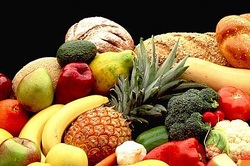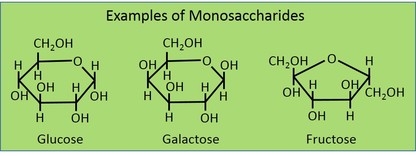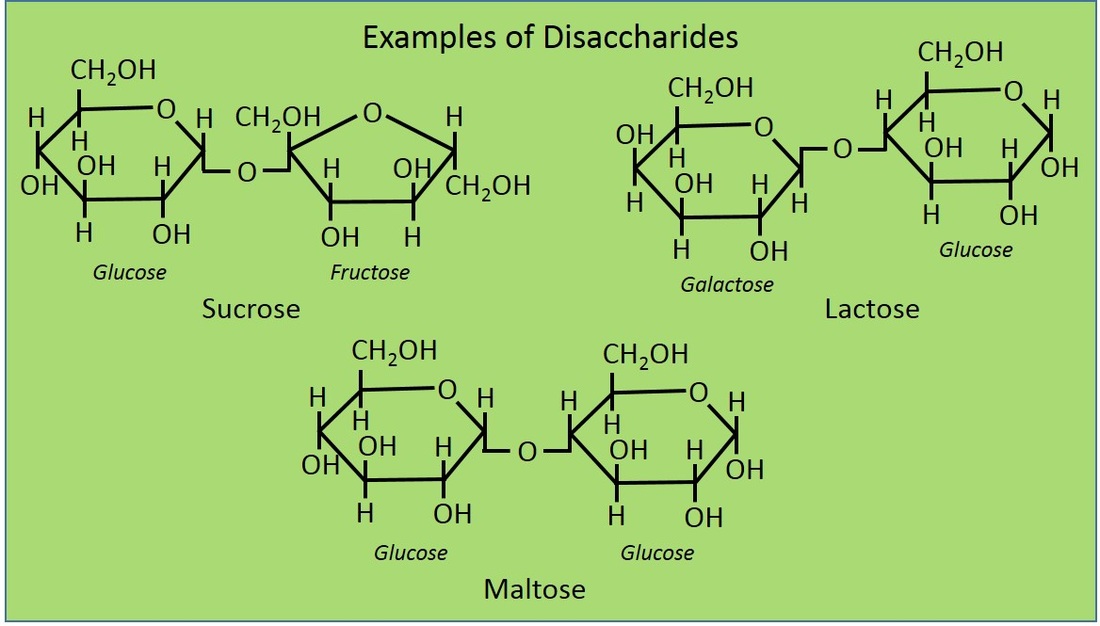
So, what exactly is a carbohydrate? The basic building block of a carbohydrate molecule is a sugar unit called a saccharide. A monosaccharide is a carbohydrate molecule with only one sugar unit; a disaccharide is a carbohydrate molecule with two sugar units linked together by a chemical bond; a polysaccharide is a carbohydrate molecule with three or more sugar units linked together by multiple chemical bonds. Common examples of sugar units (monosaccharides) include glucose (blood sugar), fructose (found naturally in fruits), and galactose (found in dairy). Glucose is the primary source of energy for your body’s cells.
What is a simple carbohydrate? A simple carbohydrate is either a monosaccharide or a disaccharide, consisting of one or two sugar units. They are relatively small molecules with at most only one chemical bond that holds sugar units together. Common examples of disaccharides include maltose (found in certain vegetables and beer), lactose (found in dairy), and sucrose (table sugar). Sucrose has a glucose and a fructose molecule chemically bound together.
Your pancreas detects how much sugar is in your blood at any given time and releases just the right amount of insulin for the job. When sugar is absorbed slowly, there is a slow, steady infusion of glucose into your blood. Your pancreas detects a gradual rise in blood sugar and slowly releases only the low amount of insulin needed for the job. Since the rise in your blood sugar is gradual, the drop in blood sugar as insulin does its job is also gradual and your body does not experience drastic changes in your blood sugar level, which minimizes your appetite and cravings for more sugar.
When sugar is absorbed quickly, there is a fast, almost instantaneous infusion of glucose into your blood. Your pancreas detects this rapid increase in blood sugar and shoots out huge amounts of insulin for the job, which the insulin does a little too well. Not only does the insulin quickly remove all the sugar you just added to your blood, your body’s feedback mechanism has a slight delay, so insulin continues to remove glucose from your blood causing your blood sugar level to drop even lower than it was before you ate. As a result, your body experiences huge swings in blood sugar levels. Low blood sugar triggers your appetite, making you hungry, and now you have new cravings for sugar. And you just ate! In order to satisfy your cravings, you are likely to overeat, leading to more fat, more hunger, and more weight gain. It’s a vicious cycle.
It doesn’t stop with getting fat. Once your adipose fat cells become filled with fat, the fatty acids then go to your organs, including your heart, liver, and kidneys. So besides getting fat, your health may suffer too – you may experience other effects including reduced organ function, higher blood pressure, lowered metabolism, and a weaker immune system. In addition, if you keep overloading your blood with sugar, you increase the risk that your body’s cells will no longer respond to insulin and stop taking in glucose from your blood. This condition is called insulin resistance and it increases your risk for type 2 diabetes!
What determines how fast sugar gets into my blood? Remember that sugar from carbohydrates can only be absorbed into the bloodstream as a single sugar unit (monosaccharide). As an analogy, imagine a container that holds LEGO building blocks with an opening that is only big enough to push one single LEGO block through at a time. Any carbohydrate that contains more than one sugar unit (disaccharides (simple carbs) and polysaccharides (complex carbs)) must be broken down by enzymes into single sugar units in order for the glucose to be absorbed through the small intestine and into the bloodstream. Think about it. To free up the glucose from a disaccharide (a simple carbohydrate with only two sugar units held together by a single chemical bond) so that the glucose can enter the bloodstream, the enzymes only have to break one chemical bond for each molecule. In the LEGO analogy, if two LEGO blocks are stuck together and they must be separated in order to fit through the opening of the container, it’s easy to pull apart only two LEGO blocks. As with two LEGO blocks, disaccharides are separated very quickly by enzymes and glucose enters the bloodstream almost instantaneously.
On the other hand, to free glucose from a polysaccharide (complex carbohydrate) such as the starch in starchy vegetables or whole grains so that the glucose can enter the bloodstream takes a lot more time and energy because these molecules have hundreds to thousands of sugar units held together by hundreds to thousands of chemical bonds! Now the enzymes must break hundreds to thousands of chemical bonds for each and every starch molecule (in the case of dietary fiber, we can't even break down all the nearly one million chemical bonds that bind as many sugar units together, which is why fiber passes through our systems undigested). In the LEGO analogy, if you’ve ever been to LEGOLand, you’ve seen the life-size objects in the park that are made from hundreds to thousands of LEGO blocks. Imagine if you had to take one of those big things apart and get each individual LEGO block into the container. It’s a LOT more work and takes a LOT more time since you can only get the LEGO blocks through the opening as fast as you can pull them apart, and you have a LOT of LEGO blocks to take apart! Likewise, it takes a lot longer to break all those chemical bonds and free up the individual sugar units, and the result is a slow, steady infusion of glucose into your bloodstream. So in addition to the benefit of a gradual change in your blood sugar, which minimizes your hunger and cravings, you burn more calories when you digest complex carbs because your body has to do more work (bonus!).

What are “bad” carbohydrates? Refined carbohydrates are the “bad” carbohydrates. The refining process strips carbohydrates of all their nutrients and fiber, so that only the simple sugar remains and your body doesn’t have to do any of the “hard work” to get at the glucose. Plus, even more refined sugar is usually added to most refined and processed foods (not to mention loads of fat, cholesterol, salt, and useless calories, making them even worse!). All that glucose gets into your bloodstream almost instantaneously, causing spikes in your blood sugar followed by crashes and then cravings for more sugar. And we’ve already discussed what happens next!
Examples of refined and/or processed foods include (and are not limited to) white rice, anything with white flour, “enriched” flour, semolina, durum, durum wheat, bleached flour, unbleached flour, enriched wheat flour, unbleached enriched wheat flour and/or added sugar such as white bread, bagels, croissants, potato chips, corn chips, pretzels, pasta (unless it’s whole grain), pancakes, waffles, many cereals, cookies, candy, sugary drinks (including Gatorade), and beer.
Think the low-fat and non-fat alternatives are better choices? Be aware that many of these processed food products replace fat with added sugar so that they still taste good.
Read labels! Every 4 grams of sugar is the same as 1 teaspoon of sugar, so you can use this to figure out how much sugar is in each serving. For example, if a cereal has 18 g of sugar per serving, it’s the same as having 4.5 tsp of simple sugar in a single serving, and how often do you limit yourself to only one serving? The American Heart Association recommends 36 g (9 tsp) for men and 24 g (6 tsp) for women of added sugar per day. If you’re an average American, you’re consuming 84 g (21 tsp) of sugar daily – too much!
Don’t be fooled by the name - sugar hides under many other names! If it ends in “ose”, it’s probably sugar. Be on the lookout for sucrose, fructose, glucose, dextrose, maltose, galactose, ribose, deoxyribose, xylose, arabinose, and lactose, or any other name ending in “ose”. Especially avoid high fructose corn syrup! Why? Because it’s like a vacation for your body since the chemical bonds of the disaccharides have already been broken for you and your body has even less work to do by not having to break any chemical bonds to get the sugar into your blood. Furthermore, research has shown that high fructose sugars inhibit the appetite-controlling hormone leptin from getting to the brain and signalling to your brain that you're full (so you eat more!). Other names for sugar include (and are not limited to) evaporated cane juice, agave nectar, fruit juice concentrate, 100% fruit juice, blackstrap molasses, organic brown rice syrup, barley malt, sorghum syrup, diastase, treacle, diastatic malt, panocha, golden syrup
What are “good” carbohydrates? Whole, unrefined carbohydrates, both simple and complex, are good carbohydrates for several reasons. They are naturally loaded with nutrients, including vitamins, minerals, and enzymes. Plus they have natural fiber so they fill you up and they help move food through your system. While the simple sugars found in fruits and vegetables (mainly fructose) do enter your bloodstream rapidly, fruits and vegetables have significantly lower amounts of simple sugars than refined and processed foods, which typically have lots added refined sugar. Complex carbohydrates are slow to enter your bloodstream, so you don’t get blood sugar spikes followed by crashes that lead to sugar cravings. And, because your body has to work harder to digest complex carbohydrates, you burn more calories.
Examples of foods with whole, unrefined carbohydrates include (and are not limited to) all whole plant-based foods such as fruits (apples, oranges, pears, plums, grapes, bananas, grapefruit, cantelope, honeydew melon, mango, watermelon, pineapple, etc.), vegetables (greens (kale, spinach, romaine lettuce, collard greens, chard, mustard greens, etc.), broccoli, cauliflower, green beans, tomatoes (technically a fruit), cucumber, avocado, peppers, sweet potatoes, yams, squash, corn, etc.), whole grains (oatmeal, brown rice, quinoa, barley, bulgur, basmati, kasha, bran cereal, whole-wheat pasta, etc.), beans and legumes (black beans, kidney beans, pinto beans, white beans, chick peas (garbanzo beans), lentils, split peas, etc.), raw nuts (walnuts, cashews, almonds, etc.), and seeds (pumpkin, sesame, sunflower, etc.).
Again, be sure to read the label! Just because it says “Natural”, “Organic”, or “Whole Grain” on the front of the package does not make it true. Turn it over and read the label on the back or side of the package. Make sure that the first ingredient is “whole” followed by the type of grain to ensure that you’re truly getting a whole-grain product.
The bottom line: your body needs carbohydrates, so don’t cut out the good carbohydrates, especially fruits, vegetables, whole grains, legumes, beans, nuts, and seeds! That would be like cutting off your nose to spite your face, a needlessly self-destructive over-reaction to your weight problem. Keep eating the good carbohydrates from whole plant-based foods. Cut out foods with processed and refined sugars and flour (and fat, especially saturated fat)! These are the real reasons you’re not losing weight!






 RSS Feed
RSS Feed